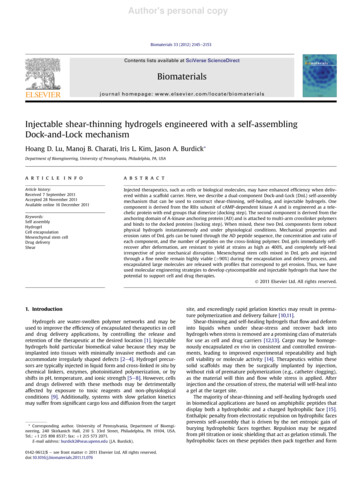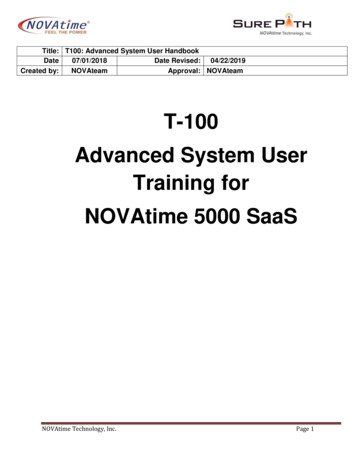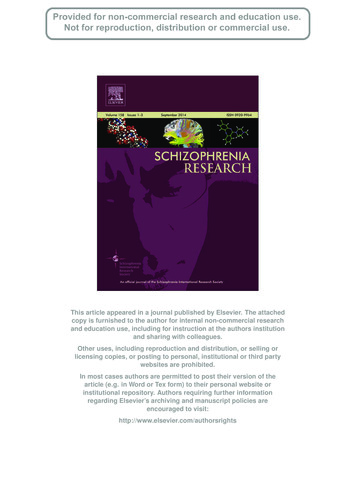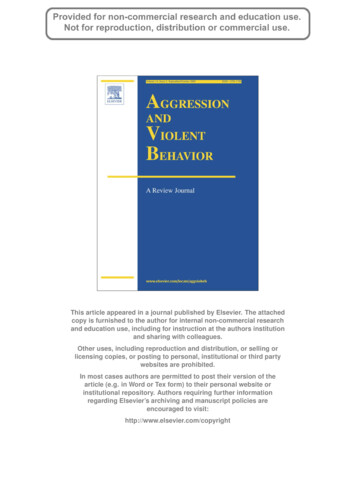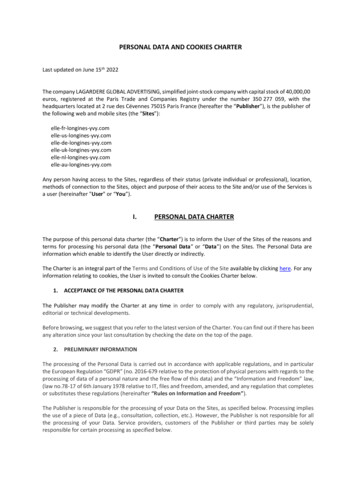
Transcription
Author's personal copyGeomorphology 122 (2010) 205–210Contents lists available at ScienceDirectGeomorphologyj o u r n a l h o m e p a g e : w w w. e l s ev i e r. c o m / l o c a t e / g e o m o r p hGeomorphic and climatic controls on chemical weathering in the HighHimalayas of NepalEmmanuel J. Gabet a,⁎, Domenik Wolff-Boenisch b, Heiko Langner c, Douglas W. Burbank d, Jaakko Putkonen eaDepartment of Geology, San Jose State University, San Jose, CA 95192, USAInstitute of Earth Sciences, University of Iceland, 101 Reykjavik, IcelandDepartment of Geosciences, University of Montana, Missoula, MT 59802, USAdDepartment of Earth Sciences, University of California, Santa Barbara, CA 93106, USAeDepartment of Geology and Geological Engineering, University of North Dakota, Grand Forks, ND 58202, USAbca r t i c l ei n f oArticle history:Received 4 April 2010Received in revised form 29 June 2010Accepted 30 June 2010Available online 7 July 2010Keywords:ErosionChemical weatheringHimalayasGlaciersMarsyandia b s t r a c tThe hypothesis that CO2 consumption by chemical weathering is enhanced by the exposure of fresh mineralsprovides a mechanism linking tectonic, geomorphic, and atmospheric processes. We present data from theHigh Himalayas of Nepal indicating a positive linear relationship between cation weathering rate andsuspended sediment yield. Because of a steep precipitation gradient across the field area, the weatheringrates are normalized according to runoff to isolate erosion as the controlling factor. Adjusted for runoff,increases in weathering rates do not keep pace with increasing erosion rates where suspended sedimentyields N 2000 t/km2/y. This result supports studies that predict a nonlinear relationship between denudationand weathering in rapidly eroding landscapes. In addition, we document a decoupling of the weathering of Siand silicate cations from a glacierized watershed. The proportions of silicate-derived Na and K are highrelative to Si during the warm summer months and then drop when subfreezing temperatures arrive in thefall. We propose that, during the summer, glacial abrasion creates fresh mineral surfaces that favor therelease of cations, and abundant meltwater flushes these weathering products from the subglacial bed. Astemperatures fall below freezing and the production of meltwater slows dramatically, river dischargebecomes dominated by groundwater bearing the chemical signature of more congruent weatheringreactions. 2010 Elsevier B.V. All rights reserved.1. IntroductionIn 1952, Urey (1952) linked climatic and geochemical processes byproposing that the weathering of Ca- and Mg-bearing silicate mineralssequesters atmospheric CO2 through the ultimate precipitation ofcalcite and dolomite. Since then, a concerted effort has been made tounderstand the fundamental controls on chemical weathering (e.g.,Berner, 1978; White and Blum, 1995; Kump et al., 2000; West et al.,2005). These investigations have been stimulated by conceptual andnumerical models that propose links and feedbacks betweenatmospheric processes, weathering, tectonic processes, and erosion(e.g., Berner et al., 1983; Raymo et al., 1988; Raymo and Ruddiman,1992; Berner, 1994).Climate, as represented by temperature and precipitation, hasbeen identified as a critical factor influencing silicate weatheringrates. The role of temperature is particularly interesting because ofthe potential negative feedback between climate and silicateweathering rates. Increases in atmospheric CO2 would raise global⁎ Corresponding author. Tel.: 1 408 924 5035; fax: 1 408 924 5050.E-mail address: manny.gabet@sjsu.edu (E.J. Gabet).0169-555X/ – see front matter 2010 Elsevier B.V. All rights tures through greenhouse effects; the increase in temperature, in turn, should enhance silicate weathering rates and lead toa decrease in atmospheric CO2, thus bringing temperatures backdown (Walker et al., 1981; Berner et al., 1983). In support of thishypothesis, White and colleagues (White and Blum, 1995; Whiteet al., 1999) concluded from the analysis of field data that theweathering of Si and silicate-derived Na are primarily controlledby climatic factors. Similarly, others have determined thatchemical denudation rates were correlated with runoff, a proxyfor precipitation (Dunne, 1978; Kump et al., 2000; West et al.,2002; France-Lanord et al., 2003).In contrast, other studies have concluded that the exposure offresh mineral surfaces by erosion is the most important factordetermining rates of chemical weathering (Stallard and Edmond,1983; Edmond et al., 1996; Huh and Edmond, 1999; Oliva et al., 2003).Indeed, Riebe et al. (2001) and Millot et al. (2002) found that chemicaldenudation was strongly correlated to erosion rate. The potentialinfluence of erosion on chemical weathering rates is intriguingbecause it provides a link between tectonic and atmosphericprocesses. Of course, both climate and erosion likely have importantinfluences on chemical weathering (Gaillardet et al., 1999; FranceLanord et al., 2003), and statistical models have been employed to
Author's personal copy206E.J. Gabet et al. / Geomorphology 122 (2010) 205–210disentangle the relative contributions of temperature, precipitation,and physical denudation (Riebe et al., 2004; West et al., 2005).Although evidence indicates that chemical weathering in theHimalayas was insufficient to have triggered global cooling in theCenozoic (e.g., Galy and France-Lanord, 1999; France-Lanord et al.,2003; Wolff-Boenisch et al., 2009), as originally proposed by Raymoand Ruddiman (1992), the high rates of erosion and the steepgradients in temperature and precipitation make it a useful region forstudying the controls on chemical weathering rates. In this contribution, we compare solute and sediment yield data from the Annapurnaregion of central Nepal, a zone that spans the breadth of the HighHimalayas and reaches into the Tibetan Plateau (Fig. 1). Whereasothers (e.g., France-Lanord et al., 2003) have previously investigatedthe general relationship between erosion and weathering in Nepal,the present study benefited from an intensive river monitoringprogram and a vast network of meteorological stations, thus offeringan unprecedented level of spatial and temporal detail in the datacollected.2. Methods2.1. Field siteIn 2000–2001, 10 river monitoring stations were established alongthe Marsyandi River and selected tributaries (Fig. 1; Table 1). This areais one of the wettest in the High Himalayas (Bookhagen and Burbank,2006) and has a strong precipitation gradient: runoff increasestwenty-fold along a 40-km transect. Air temperature was measuredat 17 meteorological stations deployed throughout the field area atelevations ranging from 1500 to 4400 m (Putkonen, 2004). The datafrom the meteorological stations were used to derive a lapse rate of5 C/km, thus allowing us to estimate temperatures in areas beyondthe reach of the network.The region is sparsely populated and only a small proportion ( 5%) ofthe area is cultivated, inhabited, or logged, thus minimizing the effects ofhuman land use impacts. Some of the watersheds in the study area areglacierized, with the area covered by glaciers ranging from 0 to 21%(Table 1); the dominant erosional process on the unglacierized slopes islandsliding (Gabet et al., 2004; Gabet et al., 2008). Bedrock in the studyarea includes sedimentary units of the Tethyan sequence, gneisses of theGreater Himalayan sequence, and schists and limestones of the LesserHimalayan sequence (Colchen et al., 1986; Searle and Godin, 2003)(Fig. 1).2.2. River samplingIn 2000–2002, channel cross sections at each station weresurveyed, flow velocities were measured, and stage poles wereinstalled to develop stage–discharge rating curves (Gabet et al., 2008).During the monsoon seasons (June–October), stage was recorded andthree suspended sediment samples were taken twice daily at eachstation; outside of the monsoon seasons, stage was recorded lessfrequently. The suspended sediment samples from each samplinginterval were filtered (25 μm mesh), dried, weighed, and averaged.The average suspended sediment concentration was multiplied by thedischarge, calibrated with data from the Tropical Rainfall MeasuringMission (Bookhagen and Burbank, 2006; Gabet et al., 2008), tocalculate a suspended sediment load; sediment loads were integratedFig. 1. Study area with the locations of river monitoring stations. Site names shown in legend. Dashed line is watershed boundary. Lithological map modified from Searle and Godin(2003).
Author's personal copyE.J. Gabet et al. / Geomorphology 122 (2010) 205–210207Table 1Watershed data.StationBasin#Lithologya Mean annual airtemp. CRunoffbm/yTotal areakm2Glacialcover %Averageelevation m2000–2002 suspended sedimentflux t/km2/y2002 sil. cation weath. SS Tibetan Sedimentary sequence; GHS(⁎) Greater Himalayan sequence (*includes the Manaslu Granite); LHS Lesser Himalayan sequence.Wolff-Boenisch et al. (2009).Italicized data not included in analyses (see Methods).Adjusted value (see text). Original value 930.throughout the monitoring season to produce an annual suspendedsediment yield. Bedload yields could not be measured directly, andthus, suspended sediment yields are assumed to be approximatelyproportional to the total physical denudation rate. Bedload has beenestimated to account for 33% of the total load (Pratt-Sitaula et al.,2007; Gabet et al., 2008).During the 2002 monsoon season, weekly water samples werecollected, filtered, split, and one aliquot was preserved with nitric acidto pH 1. The solute data and a full description of the chemicalanalyses are presented in Wolff-Boenisch et al. (2009). Briefly, cationconcentrations were determined through inductively-coupled plasmaoptical emission spectrometry, anion concentrations were measuredthrough ion chromatography, and bicarbonate concentrations weredetermined through titration. Meteoric corrections were made withrainwater samples and hydrothermal inputs were accounted for withdata from Tipper et al. (2006). The major cations were assigned tosilicate sources according to Galy and France-Lanord (1999). Finally,silicate weathering rates were normalized according to the map areaof silicate lithologies (Wolff-Boenisch et al., 2009).Of the 10 monitored watersheds, two are significantly smaller thanthe rest (Danaque and Temang; Table 1). Given the short monitoringperiod, random landslides with unknown recurrence intervals canstrongly influence calculations of the average annual suspendedsediment yields from these small watersheds; thus, the data fromthese catchments are not included in the analyses. Whereas data fromonly eight stations may seem to offer limited insight, the twice-dailysuspended sediment flux measurements and the weekly solute fluxmeasurements provide an unprecedented sampling frequency forthese processes in the High Himalayas. The accuracy and internalconsistency of the data from this monitoring program were analyzedin Gabet et al. (2008) and found to be satisfactory. Note also thatGabet et al. (2008) calculated erosion rates for the region with recordsthat spanned from 2000 to 2004. Here, we examine suspendedsediment yields determined from records up to 2002 to match thesolute data collected contemporaneously in 2002. Finally, althoughthe watersheds were only intensively monitored during the monsoon,the discharges of water, sediment, and solutes during this periodaccounts for the majority of the annual totals from the highmonsoonal flows (Tipper et al., 2006).diverse locations (Gaillardet et al., 1999; Riebe et al., 2001; Millot etal., 2002; Riebe et al., 2004; West et al., 2005; Hren et al., 2007)indicate that the dependency of chemical weathering (W) on erosion(E) can be represented as: W Eλ, where λ is a dimensionless constantwith a value depending on the weathering regime (Gabet and Mudd,2009). In slowly eroding landscapes, chemical weathering is limitedby the supply of fresh minerals and λ is close to unity (Riebe et al.,2004; Waldbauer and Chamberlain, 2005; West et al., 2005; Hren etal., 2007; Gabet and Mudd, 2009). As erosion rates increase, however,weathering becomes limited by the kinetics of the chemical reactions,and the value of λ falls below 1 such that further increases in erosionwill not yield equivalent increases in chemical weathering (Millot etal., 2002; Waldbauer and Chamberlain, 2005; Gabet, 2007; Gabet andMudd, 2009). For example, West et al. (2005) determined that, inkinetically limited situations, chemical weathering rates scale withapproximately the square root of erosion rate; a similar value wasfound by Gabet (2007) in a theoretical study of landslide-dominatedlandscapes.Wolff-Boenisch et al. (2009) concluded that chemical weatheringin our study region was kinetically limited. In addition, a compilationfrom West et al. (2005) suggests that chemical weathering iskinetically limited where denudation rates are N50 t/km2/y; theslowest eroding basin included in our analyses has a suspendedsediment flux of 265 t/km2/y (representing only a fraction of its totalerosion rate). Therefore, a nonlinear relationship (with λ b 1) betweensilicate cation weathering rate and suspended sediment flux would beexpected. The role of rainfall in flushing soil pores and preventing thebuild-up of high solute concentrations that could inhibit dissolution isa likely explanation for the anomalous linear relationship (Kump etal., 2000). The watershed with the highest weathering rate (Khudi) isalso the wettest, with an average annual runoff that is 5–20 times3. ResultsA robust linear relationship emerges between the weathering rateof cations derived from silicate rocks and the suspended sediment flux(Fig. 2). The linearity of the relationship, however, is surprising whencompared to results from others. The data presented in studies fromFig. 2. Linear relationship between the weathering rate of silicate cations and suspendedsediment flux, a proxy for erosion rate. X-axis error bars represent 1σ; y-axis error barsrepresent 27% uncertainty in weathering rates (Wolff-Boenisch et al., 2009).
Author's personal copy208E.J. Gabet et al. / Geomorphology 122 (2010) 205–210higher than the others (Table 1). Although the Khudi catchment is alsowarmer than the others, diffusive proton–cation exchanges are lesssensitive to temperature than the hydrolysis of Si–O bonds (Lasaga,1998) and, thus, precipitation likely exerts a greater influence oncation weathering rates. Indeed, Dunne (1978) documented a strongrelationship between runoff and chemical weathering and othershave found that, of the two climatic parameters, precipitation has thestrongest effect (France-Lanord et al., 2003; West et al., 2005). Finally,the air temperatures recorded by our meteorological stations likelyare not representative of the temperatures at the glacial beds wheresome fraction of the glacierized watersheds' chemical weathering wastaking place. Thus, to isolate the role of erosion in controlling chemicalweathering, the measured cation weathering rates are normalizedaccording to runoff (Table 1). Adapting West et al.'s (2005) approach,normalized weathering rates, W⁎, are calculated for each watershedwith δR β W W 1 R0ð1Þwhere W is the measured cation weathering rate, R0 is the logarithmicmean of annual runoff from all the stations, δR is the differencebetween each watershed's annual runoff and R0 (i.e., R R0), and β isa fitted parameter found by West et al. to have a value of 0.73 0.20.Although Eq. (1) does not explicitly adjust for the effect oftemperature, rainfall and temperature are highly correlated in thestudy area (r 0.98; Pearson correlation coefficient), and thus theweathering rates are, to some extent, implicitly normalized fortemperature.Accounting for the influence of precipitation bends the linearrelationship between weathering and erosion into one that isnonlinear, with the nonlinearity becoming apparent where erosionrates N2000 t/km2/y (Fig. 3). These results support studies that havedemonstrated that weathering rates initially increase linearly witherosion in slowly denuding landscapes but, as erosion ratesreach 103 t/km2/y, increases in chemical weathering are unable tokeep pace (West et al., 2005; Gabet and Mudd, 2009).4. Discussion4.1. Erosion and chemical weatheringThe Himalayas were identified by Raymo and Ruddiman (1992) asa critical region where accelerated erosion would enhance chemicalweathering rates. Our results suggest that, when erosion is isolated asthe sole controlling factor, increases in chemical weathering in theHimalayas appear unable to keep pace with increases in denudation atFig. 3. Silicate cation weathering rate normalized by runoff vs. suspended sedimentflux. Removing the influence of precipitation reveals that weathering rates increasenonlinearly with erosion. A regression equation is not fitted to the data because thenature of the relationship changes depending on the range of erosion rates (Gabet andMudd, 2009). X-axis error bars represent 1σ; y-axis error bars represent 27%uncertainty in weathering rates and 27% uncertainty in B (from Eq. (1)) propagatedthrough calculations of normalized weathering rates.the high end of erosion rates (Fig. 3). However, in reality, erosion doesnot operate in isolation, and in the Himalayas, it is strongly correlatedwith annual precipitation (Gabet et al., 2008). Therefore, to the extentthat precipitation drives erosion rates and may even concentratetectonic strain (Hodges et al., 2004), the linearity of the relationshipbetween weathering and erosion (Fig. 2) suggests that increases indenudation may be associated with equivalent increases in cationweathering rates in the Himalayas. Uplift at the range front forcesorographic precipitation that accelerates erosion rates and exposesfresher minerals to the humid environment. Indeed, the fastesteroding watershed, the Khudi, is the wettest, has the highest rates ofchemical weathering, and appears to be in a zone of recent faulting(Wobus et al., 2003; Hodges et al., 2004). Nevertheless, althoughthese processes are spatially related, the overlap is very localized;indeed, the Khudi watershed represents an area that is only a smallfraction of the entire range. The effect of enhanced chemicalweathering in the Khudi and similar Himalayan watersheds on globalCO2 levels is, thus, insignificant (Wolff-Boenisch et al., 2009).Finally, it is somewhat surprising that a clear relationship betweenerosion and weathering can be inferred from our data set. Most largescale investigations of chemical weathering deliberately choose siteswith similar bedrock, typically granite, to control for the effect oflithology on weathering rates (e.g., Riebe et al., 2004; West et al.,2005). In contrast, the watersheds in our study are underlain by avariety of silicate lithologies (e.g., granite, black shale, and gneiss) thatmay weather at different rates. Whereas the mosaic of different rocktypes might be expected to dilute the relationship between erosionand weathering, it does not appear to have an effect. It may be that, inmountainous landscapes, the dual influences of erosion and climatesimply overwhelm any differences in weathering susceptibilityarising from lithological differences. Another explanation may bethat susceptibility to chemical weathering covaries with vulnerabilityto physical erosion for individual rock types: physically weak bedrockis likely to be broken up into small fragments with greater surface areavulnerable to chemical attack. In addition to the different lithologies,including watersheds eroded by different processes might also beexpected to confound attempts to extract a relationship betweendenudation and erosion. In some watersheds, such as the Khudi,landslides are the dominant erosional process; in others, such as theNar, glaciers are dominant; and in some, like the Dudh, both areimportant. Therefore, landslides and glaciers appear to be similarlyefficient, within the measurement uncertainties, at pulverizing rockand creating fresh mineral surfaces.4.2. Incongruent weathering in a glacierized watershedOliva et al. (2003) suggested that in rapidly eroding landscapes theweathering of Si and silicate cations are decoupled, with their ratesresponding to different forcing factors. Indeed, Wolff-Boenisch et al.(2009) demonstrated that the weathering of Si in the Annapurnaregion is dependent on temperature, whereas the results presentedhere suggest that the weathering of silicate cations is primarilydependent on erosion rate. Laboratory studies under relevantexperimental conditions (circum-neutral pH, low temperature) haveindicated that the weathering of fresh feldspar surfaces is characterized by an initial release of cations and then evolves towardsstochiometric dissolution (Chou and Wollast, 1984; Muir et al.,1990; Hamilton et al., 2000). This progression has been attributed tothe development of a silicon-rich layer on the surface of weatheredminerals (Brantley, 2003; Fletcher et al., 2006). Supporting theselaboratory studies, Anderson et al. (1997) and Hodson et al. (2000)noted low Si concentrations relative to cations in glacial runoff andsuggested that subglacial grinding could stimulate the preferentialrelease of cations. In our field area, the glacierized Nar watershed iswell situated for exploring the role of erosion in incongruentweathering because glacial activity is seasonal: the glaciers are mainly
Author's personal copyE.J. Gabet et al. / Geomorphology 122 (2010) 205–210active during the summer and are relatively quiescent the rest of theyear (Gabet et al., 2008). In addition, although only 10% of the Narcatchment is glacierized, its glaciers are the dominant source of runoff,sediment and, presumably, solutes because of its high altitude andrelative aridity (Gabet et al., 2008). Other watersheds, such as theDana, have a higher fraction of glacierized area but they also havegreater rainfall, and thus, a variety of sources supply solutes to therunoff in unknown proportions.Similar to Hodson et al. (2000), we use the molar ratio ([Ks] [Nas])/[Si], where the subscript ‘s’ refers to silicate sources, as a measureof incongruent weathering (i.e., the ratio increases as incongruentweathering becomes more important). The source of the potassium isassumed to be biotite, and albite is assumed to be supplying the sodium,although amphiboles may also contribute. The concentration of Sireflects the weathering of Si from all silicate rocks, and thus, the absolutevalues of ([Ks] [Nas])/[Si] are essentially meaningless; however,changes in this ratio through time may signal changes in the chemicalweathering processes. Potassium and sodium are chosen because theirsources are well constrained. Rainwater samples were used to adjust formeteoric contributions, and Na from salt deposits was accounted for withCl concentrations, leaving silicates as the major source after corrections forhydrothermal inputs (Wolff-Boenisch et al., 2009). In contrast, Ca and Mghave important carbonate sources, and thus, some uncertainty exists indetermining the fraction of each from silicate sources.As the seasons change from summer to fall, and the air temperatureat the snout of the glaciers approaches 0 C, discharge from the Narwatershed quickly decreases (Fig. 4). A steep decline in discharge inearly September when temperatures drop below 2 C indicates thearrival of freezing temperatures higher up on the glaciers and theslowing of meltwater production. During this period of coolingtemperatures, the ([Ks] [Nas])/[Si] ratio initially decreases with thewaning discharge and then becomes approximately constant when theflow drops below 30 m3/s (Fig. 4). Given that temperature along thesubglacial beds should not vary dramatically, the decrease in the ratio isunlikely to be directly related to the change in the weather. We propose,instead, that the shift away from incongruent weathering towards morecongruent weathering may be explained by the seasonality ofmeltwater production. During the summer, when the glaciers in theFig. 4. Air temperature, river flow, cation:Si ratio, and total silicate cation flux from theNar watershed. As temperatures at the snout of the glaciers dip below 2 C in September(gray shading), discharge from glacial melt drops precipitously, weathering becomesmore congruent (i.e., the cation:Si ratio decreases), and the total cation flux decreases.209Nar catchment are the most active (Gabet et al., 2008), the production offresh mineral surfaces by glacial abrasion enhances the weathering ofcations and the abundant meltwater flushes the solutes from thepulverized subglacial sediment (Anderson, 2005). In September, thecolder temperatures inhibit the creation of meltwater, and thus, thedelivery of cation-rich runoff slows; indeed, as the flow from the Narwatershed declines by 60%, the ([Ks] [Nas])/[Si] ratio decreases by 40%,and the total cation yield decreases by 70%. Anderson et al. (1997) alsonoted the importance of meltwater in controlling chemical weatheringrates from glacierized basins. With the loss of meltwater as a significantsource of runoff, the relative contribution of groundwater to the flow inthe Nar River becomes more significant. Because the groundwater hashad longer contact times with ‘older’ mineral surfaces, the lower valuesof ([Ks] [Nas])/[Si] may reflect more congruent weathering. Forcomparison, the ([Ks] [Nas])/[Si] ratios in the non-glacierized watersheds, such as the Khudi catchment, do not suggest a shift to morecongruent weathering as temperature and discharge declines (Fig. 5). Inthese landslide-dominated basins, runoff is generated from hillslopesthroughout the catchment and it flows over mineral surfaces with afuller distribution of ages (Gabet, 2007). Therefore, in contrast to the Narwatershed, the diffuse nature of runoff generation in the Khudi basinspatially integrates the range of mineral surface ages.5. ConclusionRecently, great interest has been shown in identifying the controlson the weathering rate of silicate rocks. This interest has beenmotivated by attempts to link tectonic, geomorphic, and atmosphericprocesses. In this contribution, we present data from the HighHimalayas of Nepal that document a strong linear relationshipbetween silicate cation weathering rates and suspended sedimentyields, a proxy for erosion rate. The linear relationship suggests thatincreases in weathering rate can match increases in erosion rate. Thelinearity of the relationship, however, disappears when the weathering rates are normalized according to runoff. Isolating erosion as theFig. 5. Air temperature, river flow, cation:Si ratio, and total silicate cation flux from theKhudi watershed. In contrast to the Nar watershed, decreases in temperature,discharge, and total cation flux are not associated with a decrease in the cation:Siratio. The ([Ks] [Nas])/[Si] ratio appears to rise slightly with the arrival of fall, perhapsreflecting the role of cooling temperatures in slowing Si dissolution rates.
Author's personal copy210E.J. Gabet et al. / Geomorphology 122 (2010) 205–210sole factor in controlling weathering reveals that the increases inweathering rates begin to taper where physical denudationN2000 t/km 2/y. In addition, we present evidence suggesting thatsilicate cations are preferentially released from fresh mineral surfacescreated by subglacial grinding. During the summer when glaciers aremost active and abundant meltwater flushes solutes from the subglacialbeds, silicate-derived Na and K have higher concentrations, relative to Si,than during the remainder of the year.AcknowledgementsWe thank A. Duvall, A. Sitaula, and A. Johnstone for field help; W.Amidon for map analysis; and S. Anderson, S. Brantley, A. White, S.Mudd, and E. Tipper for the discussions. J. West, K. Norton, and twoanonymous reviewers are thanked for their attentive and insightfulreviews. This research was funded by the National Science FoundationContinental Dynamics Program (EAR-9909647), by the NationalAeronautics and Space Administration (NAGS-7781, NAGS-9039,NAGS-10520), and by the University of California, Riverside. Logisticalsupport from Himalayan Experience and the Nepalese Department ofHydrology and Meteorology is gratefully acknowledged.ReferencesAnderson, S.P., 2005. Glaciers show direct linkage between erosion rate and chemicalweathering fluxes. Geomorphology 67, 147–157.Anderson, S.P., Drever, J.I., Humphrey, N.F., 1997. Chemical weathering in glacialenvironments. Geology 25 (5), 399–402.Berner, R.A., 1978. Rate control of mineral dissolution under earth surface conditions.American Journal of Science 278, 1235–1252.Berner, R.A., 1994. GEOCARB II: A revised model of atmospheric CO2 over Phanerozoictime. American Journal of Science 294, 59–91.Berner, R.A., Lasaga, A.C., Garrels, R.M., 1983. The carbonate-silicate geochemical cycleand its effect on atmospheric carbon-dioxide over the past 100 million years.American Journal of Science 283, 641–683.Bookhagen, B., Burbank, D.W., 2006. Topography, relief, and TRMM-derived rainfallvariations along the Himalaya. Geophysical Research Letters 33. doi:10.1029/2006GL026037.Brantley, S.L., 2003. Reaction kinetics of primary rock-forming minerals under ambientconditions. In: Turekian, K.K., Holland, H.D. (Eds.), Treatise on Geochemistry.Pergamon Press, Oxford, Uk, pp. 73–117.Chou, L., Wollast, R., 1984. Study of the weathering of albite at room temperature andpressure with a fluidized bed reactor. Geochimica et Cosmochimica Acta 48,2205–2217.Colchen, M., Le Fort, P., Pecher, A.,
indicate that the dependency of chemical weathering (W) on erosion (E)canberepresentedas:W E ,where isadimensionlessconstant with a value depending on the weathering regime (Gabet and Mudd, 2009). In slowly eroding landscapes, chemical weathering is limited by the supply of fresh minerals and is close to unity (Riebe et al.,
